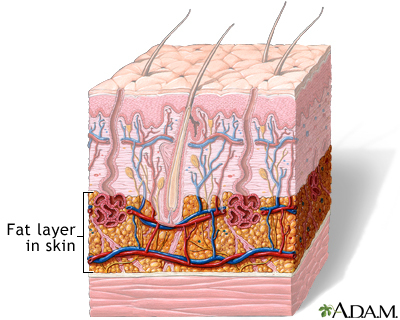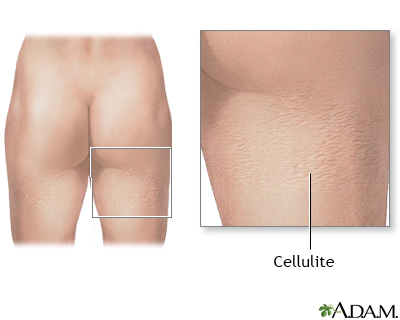Is cellulite here to stay?
http://podcasts.ufhealth.org//media/2010/02/2568-Is-Cellulite-Here-To-Stay-_-2568-Is-Cellulite-Here-To-Stay.mp3 Exercise and a good diet can go a long way toward sculpting the perfect body, but...
Update your location to show providers, locations, and services closest to you.
Cellulite is fat that collects in pockets just below the surface of the skin. It forms around the hips, thighs, and buttocks. Cellulite deposits cause the skin to look dimpled.
Everyone has layers of fat under the skin, so even thin people can have cellulite. Collagen fibers that connect fat to the skin may stretch, break down, or pull tight. This allows fat cells to bulge out.
Your genes may play a part in whether or not you have cellulite. Other factors may include:
Cellulite is not harmful to your health. Most health care providers consider cellulite a normal condition for many women and some men.
Many people seek treatment for cellulite because they are bothered by how it looks. Talk to your provider about treatment options. These include:
Be sure you understand the risks and benefits of any treatment for cellulite.
Tips for avoiding cellulite include:


American Academy of Dermatology Association website. Cellulite treatments: what really works? www.aad.org/public/cosmetic/fat-removal/cellulite-treatments-what-really-works. Accessed January 16, 2023.
Coleman KM, Coleman WP, Flynn TC. Body contouring: liposuction and non-invasive modalities. In: Bolognia JL, Schaffer JV, Cerroni L, eds. Dermatology. 4th ed. Philadelphia, PA: Elsevier; 2018:chap 156.
Hexsel DM, Katz BE, Hexsel CL. Cellulite. In: Lebwohl MG, Heymann WR, Coulson IH, Murrell DF, eds. Treatment of Skin Disease. 6th ed. Philadelphia, PA: Elsevier Limited; 2022:chap 38.
http://podcasts.ufhealth.org//media/2010/02/2568-Is-Cellulite-Here-To-Stay-_-2568-Is-Cellulite-Here-To-Stay.mp3 Exercise and a good diet can go a long way toward sculpting the perfect body, but...